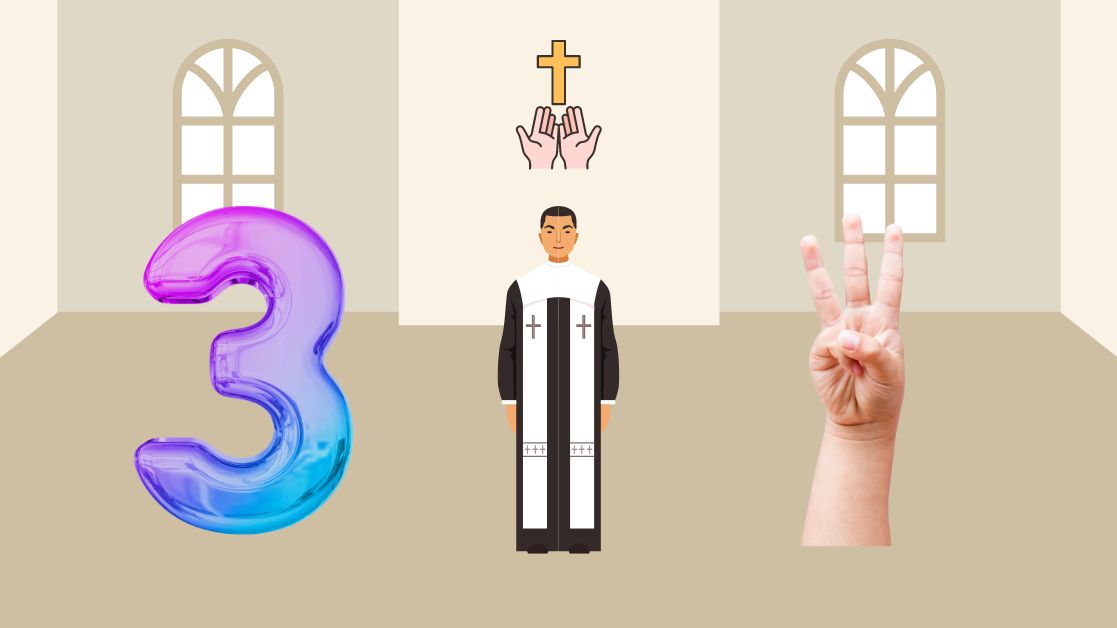The number three is found 467 times in the Bible, less frequent than the number seven, but surpasses most numerically significant figures in biblical contexts. But what does the number three mean in the Scriptures?
This article will explore the profound meaning and significance of the number 3 in the Bible.
Number Three Signifies The Holy Trinity
The number 3 is often associated with completeness and wholeness in the Bible. This idea is rooted in the concept of the Holy Trinity – the Father, the Son, and the Holy Spirit – which embodies the perfect unity of God. Just as the Holy Trinity represents God’s complete and harmonious nature, the number 3 symbolizes completeness in various biblical contexts.
Number Three Symbolizes Unity and Harmony
The number 3 is also associated with unity and harmony. It represents the perfect union of elements or individuals, often seen in the Bible as a harmonious relationship between God, humanity, and creation.
In Genesis 18, three mysterious visitors come to Abraham’s tent. These visitors are traditionally understood to represent the Holy Trinity, symbolizing the unity of God. They deliver the news of Sarah’s impending pregnancy, highlighting God’s divine intervention.
In 1 Corinthians 13:13, the apostle Paul highlights the unity and balance of these three virtues: faith, hope, and love. This bible verse shows that these virtues work together to form a harmonious Christian life.
The Significance of Three Days
In the Gospel of John, Jesus made a declaration that left the Jews bewildered. He proclaimed that if the temple were to be destroyed, He would raise it again in three days. This statement was met with incredulity because the temple had taken forty-six years to be built, and He claimed to raise it in just three days (John 2:20).
As the fateful day of His crucifixion drew near, Jesus shared another prophecy with His disciples, foretelling His impending betrayal, death, and resurrection on the third day (Matthew 17:22-23).
While it was impossible for a structure as complex as the temple to be reconstructed over a mere weekend, Christ was preparing to perform something far more astonishing – His resurrection from the dead.
Through the recurring motif of three days, Jesus ingeniously bridged two profound ideas: the physical temple as a building and His own body as a spiritual temple.
In Matthew 12:40, Jesus drew attention to the story of Jonah, who spent three days and three nights inside the belly of a great fish. This miraculous survival indicated that Jonah could have only lived through God’s divine will, as he should have perished under ordinary circumstances.
Similarly, in John 11:39, Martha expressed concerns to Jesus about the stench that would have undoubtedly arisen from Lazarus’ tomb. She pointed out that three whole days had passed since Lazarus’ death.
These instances of the number three emphasized the unmistakable passage of time, reinforcing the significance of the waiting period and the impossibility of restoring life.
In Jewish culture, three days beyond the time of death was considered a definitive sign of death. Jonah, Lazarus, and Jesus should have succumbed to death, yet Jesus decisively conquered death by waiting until the third day to rise.
Repetitive Patterns of Threes
In the Scriptures, there is a deliberate emphasis on certain statements through the use of repetition, often occurring in sets of three. For instance, Jesus forewarned Peter that the rooster would crow three times after Peter denied Him (Luke 22:34).
Despite Peter’s initial disbelief and denial, the repetition of this prediction was meant to ensure that Peter would remember Jesus’ words. Christians can draw hope from this, especially when we falter or conceal our faith. Jesus, in His foreknowledge, understood Peter’s actions and continued to love his disciples unwaveringly.
Furthermore, Jesus later provided Peter with a chance at redemption, offering him the opportunity to counter each of his earlier denials with a declaration of love. This vital interaction is recounted in John 21:17.
While it might appear repetitive out of context, it was, in fact, a significant act of redemption. Each time Peter pledged to care for Jesus’ sheep, it symbolized the Messiah’s forgiveness and the assurance that Peter could leave his guilt behind.
Bottom Line
In moments of doubt and challenge, remember the story of Peter, who denied Jesus three times but was offered redemption and forgiveness.
Let us embrace the power of forgiveness, both in seeking it and offering it to others, for it mends the fractures in our community and strengthens our bond.
Furthermore, let us draw inspiration from the three-day motif, where faith makes the seemingly impossible possible. Just as Jonah, Lazarus, and Jesus overcame their apparent hopelessness on the third day, we can rise above our difficulties with unwavering trust in the divine.
Remember that we are not just individuals on a personal spiritual journey but a community on a collective pilgrimage of faith.
As a community pastor, I encourage you to keep the flames of faith burning brightly in your hearts, knowing that, like the number three in the Bible, it signifies the completeness, unity, and divine potential that can transform our lives and our community for the better.




